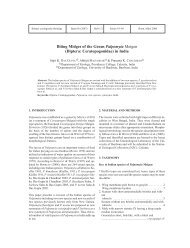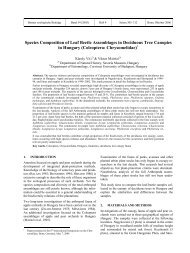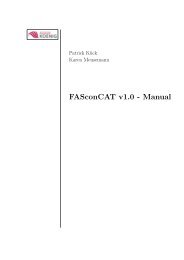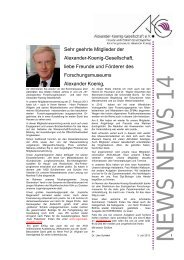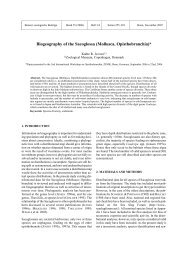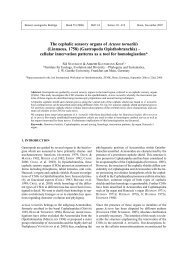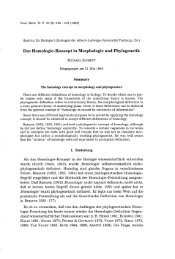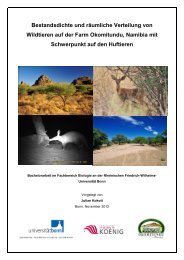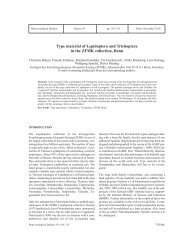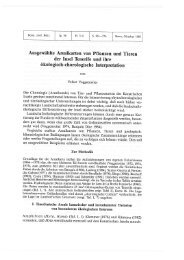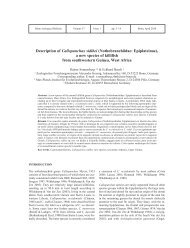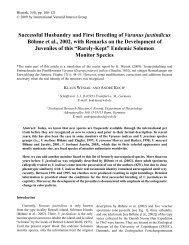Islands Between the Realms: A Revised Checklist of the ...
Islands Between the Realms: A Revised Checklist of the ...
Islands Between the Realms: A Revised Checklist of the ...
You also want an ePaper? Increase the reach of your titles
YUMPU automatically turns print PDFs into web optimized ePapers that Google loves.
118 André KOCH et al.: A <strong>Revised</strong> <strong>Checklist</strong> <strong>of</strong> <strong>the</strong> Herpet<strong>of</strong>auna <strong>of</strong> <strong>the</strong> Talaud Archipelago, Indonesia<br />
Fig. 12.<br />
Eutropis cf. rudis from Salibabu Island. Photo by André Koch.<br />
& ALCALA (1980) in having 20 and 22 keeled lamellae under<br />
fourth toe, 32 and 30 midbody scale rows (usually<br />
28–30, rarely 31 or 32; 28–31 in E. rudis from Sulawesi<br />
according to HOWARD et al. [2007]), respectively. A postnasal<br />
is present. The hind limbs <strong>of</strong> MZB Lac. 5142 reach<br />
<strong>the</strong> axilla as postulated by DE ROOIJ (1915), while MZB<br />
Lac. 5113 exhibits tricarinate dorsals as typical for E. rudis.<br />
The second specimen’s dorsal scales have up to five<br />
keels (very rarely in E. rudis according to BROWN & AL-<br />
CALA [1980]), <strong>of</strong> which <strong>the</strong> three medians are strongly pronounced<br />
and flanked by two feeble outer keels. The Talaud<br />
specimens share this character with <strong>the</strong> newly described<br />
E. grandis from Sulawesi (HOWARD et al. 2007),<br />
from which, however, <strong>the</strong>y are clearly distinguishable by<br />
higher midbody scale counts (30–32 vs. 25–27 in E. grandis).<br />
In contrast to BROWN & ALCALA (1980) and HOWARD<br />
et al. (2007) both vouchers have 40 paravertebral rows (vs.<br />
34–38 in Philippine E. rudis and 34–35 in Sulawesian E.<br />
rudis, respectively) between parietals and base <strong>of</strong> tail. The<br />
dorsal side is brown, laterally with a dark brown streak<br />
starting behind <strong>the</strong> nostrils, bordered above by a light<br />
brown streak; ventral side light grey, supralabials also<br />
grayish. In specimen MZB Lac. 5113 <strong>the</strong> ventral side is<br />
light gray only on <strong>the</strong> first half <strong>of</strong> <strong>the</strong> body; <strong>the</strong> rest including<br />
hind limbs and tail is brownish.<br />
Because both voucher specimens are not fully grown, <strong>the</strong><br />
identification as ei<strong>the</strong>r E. rudis or E. multifasciata is not<br />
unequivocal. Deviations in vertebral scale counts from<br />
those provided by BROWN & ALCALA (1980) may be explained<br />
by geographic variation. Therefore, we here preliminarily<br />
allocate <strong>the</strong>m to E. cf. rudis. Fur<strong>the</strong>r investigations<br />
will reveal if E. rudis really inhabits <strong>the</strong> Talaud <strong>Islands</strong>.<br />
Lamprolepis smaragdina ssp. (Lesson, 1830) (Fig. 13)<br />
Material examined: none<br />
Additional material: ZMA 11304 (1 spec.), Karakelang<br />
(= Karakelong), coll. H. J. LAM 1926; ZMA 18231 (1<br />
spec.), Liroeng (= Lirung), Salibabu, coll. H. J. LAM<br />
1926.<br />
Fig. 13. Lamprolepis smaragdina ssp. from Salibabu Island.<br />
Photo by André Koch.




